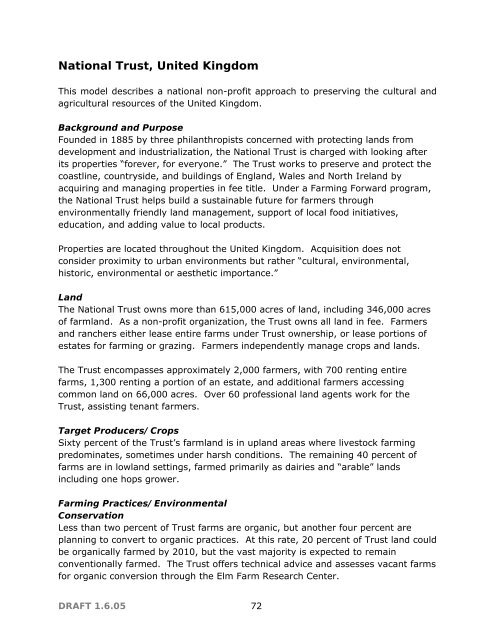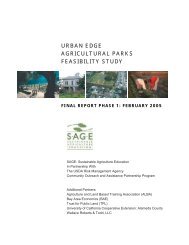A Feasibility Study for Urban Edge Agricultural Parks - SAGE
A Feasibility Study for Urban Edge Agricultural Parks - SAGE
A Feasibility Study for Urban Edge Agricultural Parks - SAGE
Create successful ePaper yourself
Turn your PDF publications into a flip-book with our unique Google optimized e-Paper software.
National Trust, United KingdomThis model describes a national non-profit approach to preserving the cultural andagricultural resources of the United Kingdom.Background and PurposeFounded in 1885 by three philanthropists concerned with protecting lands fromdevelopment and industrialization, the National Trust is charged with looking afterits properties “<strong>for</strong>ever, <strong>for</strong> everyone.” The Trust works to preserve and protect thecoastline, countryside, and buildings of England, Wales and North Ireland byacquiring and managing properties in fee title. Under a Farming Forward program,the National Trust helps build a sustainable future <strong>for</strong> farmers throughenvironmentally friendly land management, support of local food initiatives,education, and adding value to local products.Properties are located throughout the United Kingdom. Acquisition does notconsider proximity to urban environments but rather “cultural, environmental,historic, environmental or aesthetic importance.”LandThe National Trust owns more than 615,000 acres of land, including 346,000 acresof farmland. As a non-profit organization, the Trust owns all land in fee. Farmersand ranchers either lease entire farms under Trust ownership, or lease portions ofestates <strong>for</strong> farming or grazing. Farmers independently manage crops and lands.The Trust encompasses approximately 2,000 farmers, with 700 renting entirefarms, 1,300 renting a portion of an estate, and additional farmers accessingcommon land on 66,000 acres. Over 60 professional land agents work <strong>for</strong> theTrust, assisting tenant farmers.Target Producers/CropsSixty percent of the Trust’s farmland is in upland areas where livestock farmingpredominates, sometimes under harsh conditions. The remaining 40 percent offarms are in lowland settings, farmed primarily as dairies and “arable” landsincluding one hops grower.Farming Practices/EnvironmentalConservationLess than two percent of Trust farms are organic, but another four percent areplanning to convert to organic practices. At this rate, 20 percent of Trust land couldbe organically farmed by 2010, but the vast majority is expected to remainconventionally farmed. The Trust offers technical advice and assesses vacant farms<strong>for</strong> organic conversion through the Elm Farm Research Center.DRAFT 1.6.05 72





